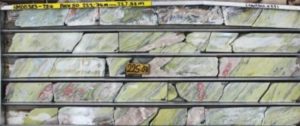Cardinal releases final assays from Ghana gold project

 Cardinal Resources Ltd. [CDV-TSX, ASX; CRDNF-OTC] has received the final tranche of assay results from its current phase of infill resource drilling at the Namdini gold project in Ghana, West Africa. These and earlier results, released on January 22, 2018, will now form the basis for an update to the mineral resource estimate which is expected to be delivered at the end of the March quarter, the company said in a press release.
Cardinal Resources Ltd. [CDV-TSX, ASX; CRDNF-OTC] has received the final tranche of assay results from its current phase of infill resource drilling at the Namdini gold project in Ghana, West Africa. These and earlier results, released on January 22, 2018, will now form the basis for an update to the mineral resource estimate which is expected to be delivered at the end of the March quarter, the company said in a press release.
Ranking high among the more politically stable countries on the African continent, Ghana has been a happy hunting ground for gold explorers, developers and producers for over 120 years.
Most of that activity has centred on southern Ghana, which remains one of the world’s most prolific areas for gold exploration and production, producing 4.13 million ounces of gold in 2016, up from 2.8 million ounces the previous year.
According to the a previous update, which was announced on September 18, 2017, Namdini has an indicated mineral resource of 4.3 million ounces of gold and an inferred resource of 3.1 million ounces at a 0.5 g/t gold cut-off grade.
That marks a four-fold increase from an April 2017 resource update of 931,000 ounces in the indicated category and 3.6 million ounces in the inferred category. Mineral resources are categorized in order of increasing geological confidence as inferred, indicated or measured.
Cardinal Resources CEO Archie Koimtsidis has described Namdini as a “brand new discovery,” and said it ranks as one of the biggest West African gold discoveries in the past decade.
Indeed, there is clear potential for an interim resource in excess of 6 million ounces, according to Toronto-based Clarus Securities Inc. and Hartleys Ltd. of Perth Australia.
The Namdini deposit is a structurally-controlled orogenic deposit with numerous features similar to deposits found elsewhere in late Proterozoic Birminian terranes of West Africa.
The property on which it is located is in the upper northeastern region of Ghana, approximately 30 km southeast of the regional centre of Bolgatanga.
Optimism is predicated on the fact that most of the indicated resource is continuous from surface to a depth of about 350 metres, making it highly amenable to a simple, large-scale open-pit with an anticipated very low strip ratio.
Results announced after the close of trading on Wednesday are the final tranche of drill results from the infill drilling program which is specifically designed with the objective of increasing the confidence level in the 3.1 million ounces of inferred gold resources by upgrading that material into the indicated mineral resource category, which currently stands at 4.3 million ounces at 0.5 g/t gold cut-off grade.
Highlights include 17 metres of 5.4 g/t gold, 50 metres of 2.3 g/t gold, and 34 metres of 2.4 g/t gold.
The measured and indicated mineral resources will drive the company’s open pit design and mining schedule for the pre-feasibility study that is well underway, and expected to be completed by mid-2018.
On Thursday, Cardinal shares rose $0.01, or 2% higher, to 52 cents.
